Pfsense in Azure - Cannot reach host on IPsec tunnel
-
I have the same problem. I NAT private ip inside phase 2 of the tunnel and the traffic goes to the other side and returns to pfsense, but VM that i initiate traffic from does not receive reply. like the traffic stops to pfsense and does not forward back to the vm. i have ip forwarding setted up a route table in Azure .
-
@stephenw10
The tunnel is established but on the dashboard it says it's down but guessing that is a bug in pfsense?

I can't ping or trace out from pfsense or VM, it doesn't receive any packets which makes me think it's not able to find a route there.
here's my nat rules:

in case you need it:
WAN rules:
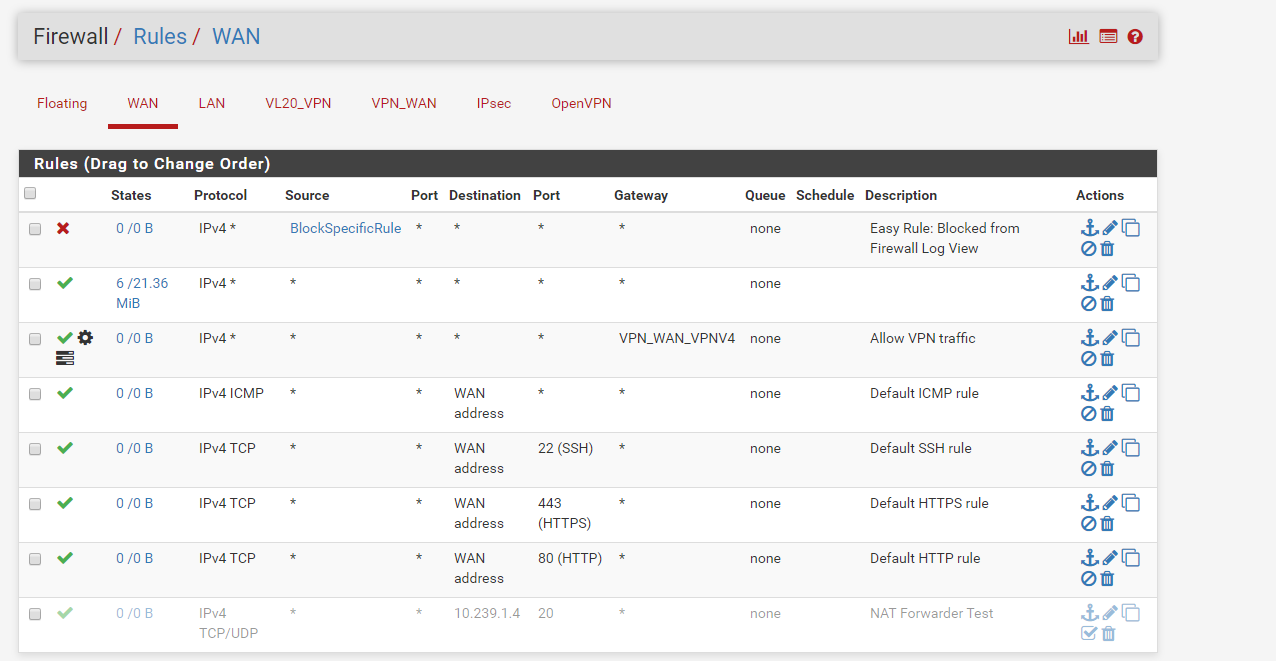
LAN rules:
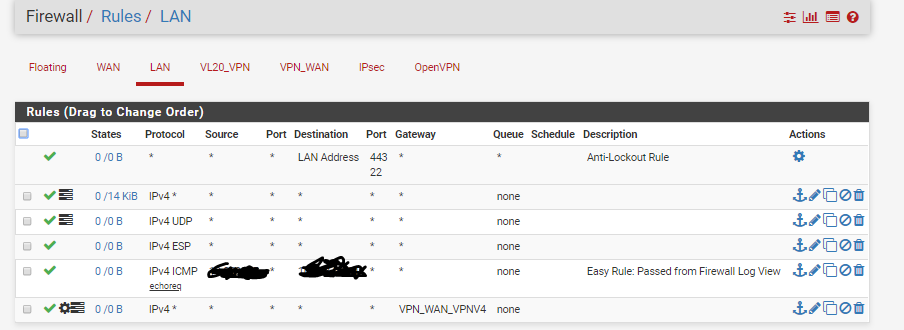
and IPsec rules:

IPsec setup:
P1:
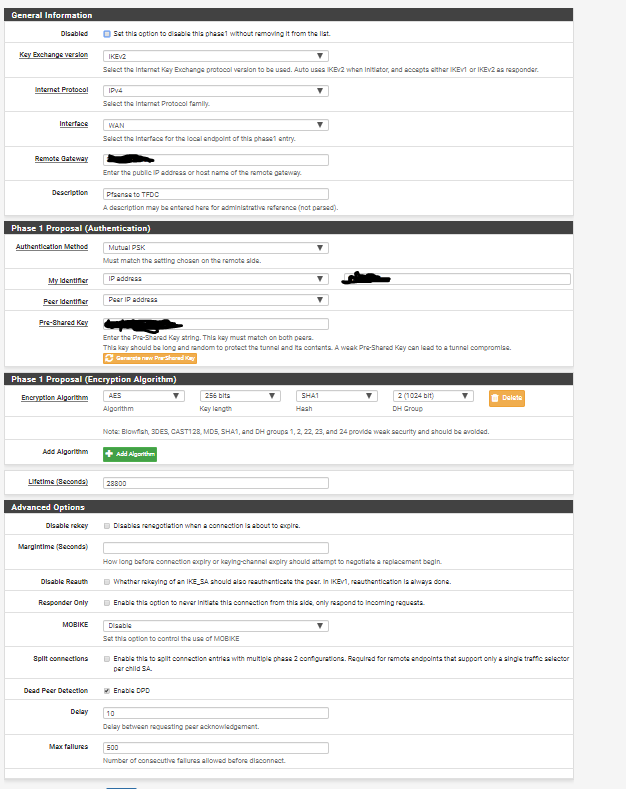
P2:
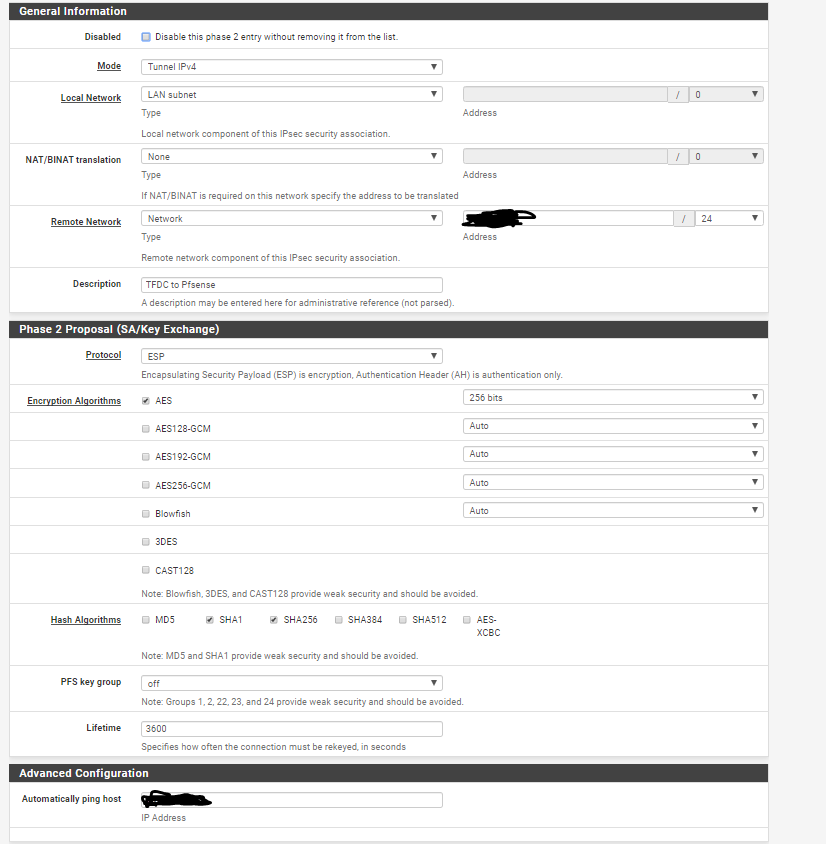
thanks
Ben -
Is the remote network a public subnet there?
You should not need to NAT anywhere. You definitely should not be NATing on all the interfaces like that. And you absolutely should never NAT on the IPSec interface like that. NAT in the P2 config if you need to NAT over IPSec.
So I would disable or remove those rules there.Also if you are adding outbound NAT rules you should use some source other than 'any'. For instance with those rules you have it will be NATing it's own IPSec traffic outbound which can only break things.
If the tunnel is up you should be able to ping to something on the remote side using the LAN IP as source. If you cannot either the tunnel is not up or it's blocked at the remote end.
Show us the IPSec status page.Steve
-
The remote address space is private and at the moment only consists of one IP which i am performing tests on.
Ok i have removed all NAT rules but it doesn't work still if i try to ping. According to documentation and some videos i've watched you need to have NAT which is why i set that up but you're saying i don't need to set this up under firewall>nat? It seems if i try to use NAT in P2 it removes it once i've saved?
Here's the IPsec status page:

-
Ok, so that's not up at phase 2, the private subnets. So you probably have a config mismatch there.
You will see the 'Show Child SAs' button there when that is established.Check the IPSec log for errors. Make sure both ends are configured the same.
The only place you need NAT there is in the phase 1 tunnel as it looks like there is some NAT in the route. However you can see it gas detected that and connected in NAT-T mode.
Steve
-
Oh i didn't know that box existed for show child sa's, yes it does appear that p1 is up and p2 is down.
I've double checked the config and it all matches up.
IPSec log does show information on child SA, i've pasted part of the log below:
Dec 16 17:32:49 charon 09[IKE] <con1000|46> establishing CHILD_SA con1000{1773} reqid 38
Dec 16 17:32:49 charon 09[ENC] <con1000|46> generating CREATE_CHILD_SA request 19 [ N(ESP_TFC_PAD_N) SA No KE TSi TSr ]
Dec 16 17:32:49 charon 09[NET] <con1000|46> sending packet: from <local>[4500] to <remote>500] (348 bytes)
Dec 16 17:32:49 charon 09[NET] <con1000|46> received packet: from <remote>[4500] to <local>[4500] (76 bytes)
Dec 16 17:32:49 charon 09[ENC] <con1000|46> parsed CREATE_CHILD_SA response 19 [ N(NO_PROP) ]
Dec 16 17:32:49 charon 09[IKE] <con1000|46> received NO_PROPOSAL_CHOSEN notify, no CHILD_SA built
Dec 16 17:32:49 charon 09[CFG] <con1000|46> configured proposals: ESP:AES_CBC_256/HMAC_SHA2_256_128/MODP_1024/NO_EXT_SEQ
Dec 16 17:32:49 charon 09[IKE] <con1000|46> failed to establish CHILD_SA, keeping IKE_SA
Dec 16 17:32:49 charon 09[CHD] <con1000|46> CHILD_SA con1000{1773} state change: CREATED => DESTROYING
Dec 16 17:32:49 charon 09[IKE] <con1000|46> activating new tasks
Dec 16 17:32:49 charon 09[IKE] <con1000|46> nothing to initiate -
@bhodges said in Pfsense in Azure - Cannot reach host on IPsec tunnel:
NO_PROPOSAL_CHOSEN
Yup so some mismatch with the other side, not the actual subnets:
https://docs.netgate.com/pfsense/en/latest/vpn/ipsec/ipsec-troubleshooting.html#phase-2-encryption-algorithm-mismatchIt's connected as AES-128/SHA1 at phase1. It's common to use the same at phase2 but not required. Do you know what the other side is set to?
Steve
-
For phase 2 it is set to AES-256 and SHA-256 which is what pfsense is set to so i'm not sure it is a mismatch?:
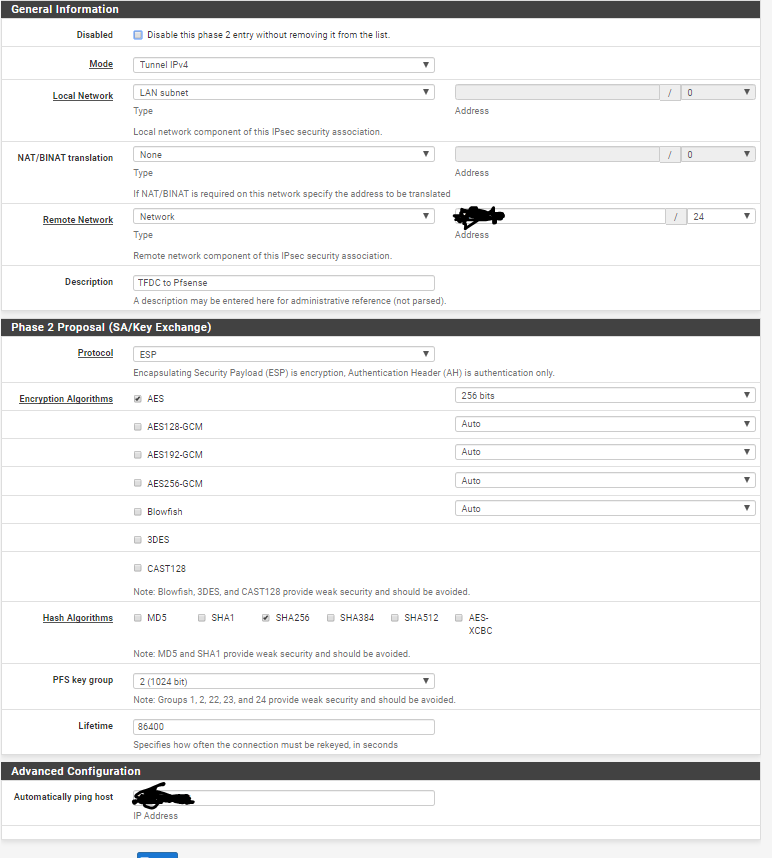
-
Different PFS key set at the other side?
The other side is sending that response so logs from that would probably show exactly what's not matching.
Steve
-
Hey Stephen,
Ok phase2 is up and the issue was with NAT. I added a NAT rule in phase2 for the whole network which pfsense sits on.
I can now ping from within pfsense to a server down the tunnel and vice versa.
My next issue is that i can't ping the server on the other side of the tunnel from another VM in the same network or another network.
I've setup ip forwarding on the pfsense interfaces in azure and created a route table to which has the address space on other side of tunnel to go through the pfsense LAN IP address.
This is the response i get if i tracert from the other VM:
Tracing route to <Server> [IP]
over a maximum of 30 hops:1 1 ms <1 ms 1 ms <LANIP>
2 * * * Request timed out.
3 <LANIP> reports: Destination host unreachable.it's being picked up on firewall logs and is being accepted:

do i need to be setting up a NAT forward so it knows what to do with the packet when it receives one destined for a host down the tunnel?
thanks
Ben -
If you can ping from pfSense to something across the VPN when selecting the appropriate source but not from another host in that subnet it sounds like a routing issue at the host.
You might have policy routing in place that re-routes traffic from the host but would not affect traffic from pfSense itself.Steve
-
it sounds as though i have the same issue as mbogoev explained above.
it seems as though the host where the traffic is originating from is routing traffic correctly to the pfsense LAN interface but it doesn't go beyond that.
in pfsense i have a static route for the network on the other side of the tunnel. If i disable this then tracert gets 'request timed out' errors for 30 hops. If i enable this then i get one 'request timed out' and then 'destination host unreachable' - the same error i sent in my previous message.
This is what i see in the packet capture:
12:18:51.842993 IP 10.233.2.4 > 10.128.2.181: ICMP echo request, id 1, seq 500, length 72
12:18:51.844700 IP 10.233.2.4 > 10.128.2.181: ICMP echo request, id 1, seq 501, length 72
12:18:51.846129 IP 10.233.2.4 > 10.128.2.181: ICMP echo request, id 1, seq 502, length 72
12:18:52.862071 IP 10.233.2.4 > 10.128.2.181: ICMP echo request, id 1, seq 503, length 72
12:18:52.862157 ARP, Request who-has 10.128.2.181 tell 10.239.3.5, length 28
12:18:56.853012 IP 10.233.2.4 > 10.128.2.181: ICMP echo request, id 1, seq 504, length 72
12:18:56.853074 ARP, Request who-has 10.128.2.181 tell 10.239.3.5, length 28
12:19:00.860894 IP 10.233.2.4 > 10.128.2.181: ICMP echo request, id 1, seq 505, length 72
12:19:00.860954 ARP, Request who-has 10.128.2.181 tell 10.239.3.5, length 28
12:19:04.864868 IP 10.233.2.4 > 10.128.2.181: ICMP echo request, id 1, seq 506, length 72
12:19:04.864932 ARP, Request who-has 10.128.2.181 tell 10.239.3.5, length 28
12:19:08.857729 IP 10.233.2.4 > 10.128.2.181: ICMP echo request, id 1, seq 507, length 72
12:19:08.857809 ARP, Request who-has 10.128.2.181 tell 10.239.3.5, length 28
12:19:12.861699 IP 10.233.2.4 > 10.128.2.181: ICMP echo request, id 1, seq 508, length 72
12:19:12.861766 ARP, Request who-has 10.128.2.181 tell 10.239.3.5, length 28it doesn't appear to be responding to the ARP requests
-
Where did you capture that? What hosts are those IPs shown there?
What exactly is the static route you have in place?
-
i clicked on packet capture from the diagnostics menu within pfsense.
10.233.2.4 is just a test vm in another network i've created
10.128.2.181 is IP on other end of IPsec tunnel
10.239.3.5 is the LAN IP of pfsense -
I assume you're capturing on the LAN interface?
It looks like you have a subnet conflict though. pfSense is ARPing for 10.128.2.181 from 10.239.3.5 it will only do that if they are inside the same subnet. It would be a huge subnet configured there though.
Steve
-
yes that's right, i am capturing on the LAN interface.
It has to come from 10.239.3.5 though? the test vm has to have a route table telling it to go to the LAN address of pfsense so it can contact the 10.128.2.181 because 10.239.3.5 is the only interface which knows of this network. So i've created a route table telling the VM to send all traffic for 10.128.2.0/24 through 10.239.3.5 and this is picked up on tracert, firewall logs on pfsense and packet trace.
How else could VM's use the IPsec tunnel?
thanks
Ben -
The static route is in Azure then? That's correct if so.
Still left with pfSense trying to ARP for a device in a subnet on the other end of the VPN. That should never happen.
It implies you have the LAN subnet configured as something huge that contains it like /9.
Steve
-
Yes there is a static route in azure which is..

then one in pfsense which is..

and then i've setup a firewall nat outbound rule:

"It implies you have the LAN subnet configured as something huge that contains it like /9." the lan subnet is a /24, i have setup NAT on phase 2 of the whole network /16 and this is only setting which works.
thanks
Ben -
Ok you should not need that static route in pfSense unless you need to send traffic from the firewall itself in which case it can be applied as a workaround:
https://docs.netgate.com/pfsense/en/latest/vpn/ipsec/accessing-firewall-services-over-ipsec-vpns.htmlYou should never apply NAT using pf on the IPSec interface, that's what is breaking the traffic here. The IPSec interface does not have an address in tunnel mode.
Any NAT you need across the IPSec tunnel must be configured in the P2 settings.Steve
-
Ok now that i have removed the NAT outbound rule and the gateway the test vm isn't routing to pfsense LAN at all and just gets timeouts. i've set everything back up again but still it isn't routing to the LAN. I have rebooted the box and things seem to be back to normal again.
The link you have sent is what i have in place already. I have a lan gateway setup with a static route. Or are you saying i shouldn't have that in place for my scenario?
I have disabled the NAT outbound rule but only put it there as things aren't routing and i'm assuming pfsense LAN doesn't know what to do with the packet when it receives it.
I essentially just need pfsense to act like the role in windows server which handles routing so when a VM sends a packet for a VM it routes to pfsense who then forwards that packet onto the destination since it is the only one who knows where to send it. i've set the azure side up the same in this scenario but just don't know what i'm missing in pfsense?
thanks
Ben